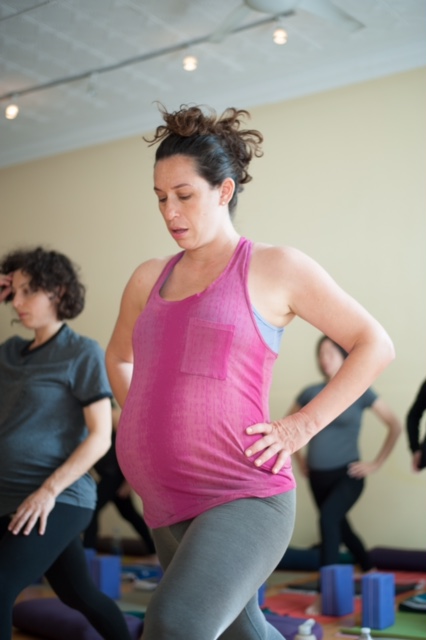I started teaching prenatal yoga almost 16 years ago. At the time, yoga had not become mainstream and prenatal yoga was not an up and coming discipline like it is now. My introduction to prenatal yoga was from a teacher based in Iyengar yoga so there was very little flow and movement between the poses. While I enjoyed the precise alignment and mindfulness of the poses, it felt like there might be better ways to encourage an exploration of the pregnant body and a link between breath and movement. Soon after receiving my prenatal yoga teaching certificate, I started studying with vinyasa yoga teacher, Shiva Rea, who’s known for her free-flowing sequences that straddle the disciplines of world dance and traditional asana.
I started to formulate my own approach to prenatal yoga, based on my understanding of asana and how it can help prepare women for birth. During the birth of what is now the Prenatal Yoga Center methodology, I was also beginning to attend births as a labor support doula. What I learned as a witness to birth was the importance of breath, movement, ritual and relaxation. When women were encouraged to move, it helped them keep the rhythm of their breath and they were often able to relax into the intensity of the contractions. When women were restricted or confined, the contractions were perceived to be of greater discomfort.
With that idea in mind, and my own background in dance and movement paired with the “waves” in which Shiva Rea teaches, I slowly constructed a prenatal teaching template based on vinyasa yoga. Vinyasa is a style of yoga which coordinates movement with breath to flow from one pose to the next. Given we want to teach women to move and breath to find relaxation, the vinyasa style seems the perfect vehicle to help women prepare for birth.
Most vinyasa classes are sequenced easy to hard. Meaning the intensity of the poses build with each wave of poses, just like in labor. The natural sequence of most labor starts with mild menstrual like cramps and eventually leads to very strong, intense contractions. One of my main take aways from working with Shiva was the space between the waves. Upon returning to the front of the mat after having completed the poses on the right side and then left, there was a change of pace. Usually a short group of poses that changed the rhythm and intensity experience in the main wave of poses. For me, I always welcomed these shorts breaks since they gave me time to regain my energy, strength and focus for the next wave of poses. (Are you starting to see the similarities with birth?)
In the PYC methodology, we adhere to this idea of building the stages and intensity of poses with a mindful space between the waves. This space – like the time between contractions -becomes an opportunity to learn how to let go of any tension and stress that might have been experienced in the previous wave and prepare from a relaxed state for the next wave of poses (or contraction!). We then sprinkle in coping mechanisms for moving through the intense sensation naturally felt in the pose and often add additional movements to the upper body to continue to remind the students to connect breath and movement. This starts to build trust in the body’s natural ability to move through discomfort as well as create familiarity with the cycle of labor.
The ultimate purpose of the PYC methodology of prenatal yoga is to best serve women in their preparation for labor and motherhood. I believe vinyasa yoga taught in a mindful way, can best do that.







